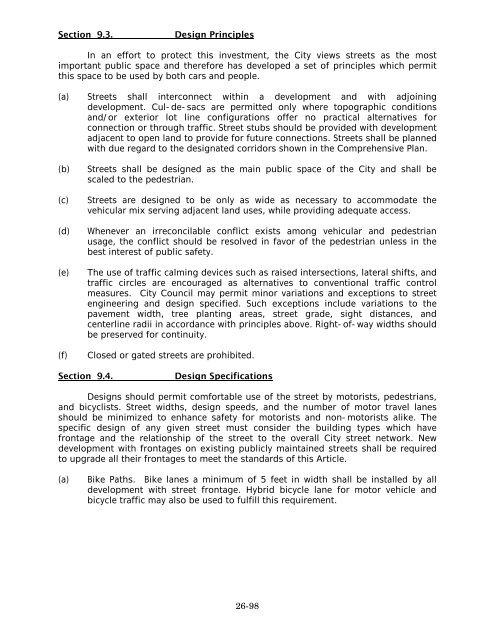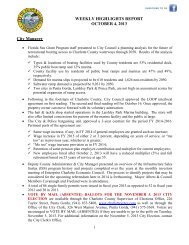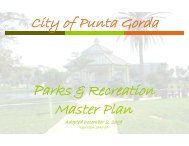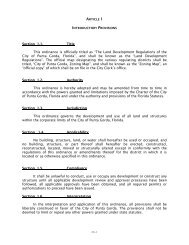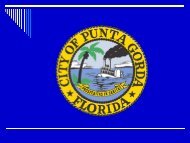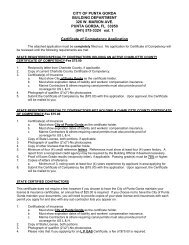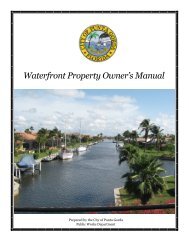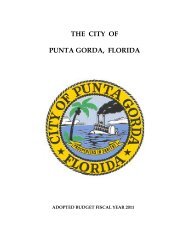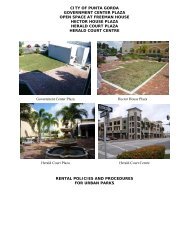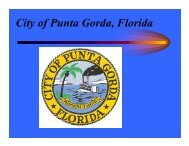Chapter 26 - City of Punta Gorda
Chapter 26 - City of Punta Gorda
Chapter 26 - City of Punta Gorda
Create successful ePaper yourself
Turn your PDF publications into a flip-book with our unique Google optimized e-Paper software.
Section 9.3. Design Principles<br />
In an effort to protect this investment, the <strong>City</strong> views streets as the most<br />
important public space and therefore has developed a set <strong>of</strong> principles which permit<br />
this space to be used by both cars and people.<br />
(a) Streets shall interconnect within a development and with adjoining<br />
development. Cul-de-sacs are permitted only where topographic conditions<br />
and/or exterior lot line configurations <strong>of</strong>fer no practical alternatives for<br />
connection or through traffic. Street stubs should be provided with development<br />
adjacent to open land to provide for future connections. Streets shall be planned<br />
with due regard to the designated corridors shown in the Comprehensive Plan.<br />
(b) Streets shall be designed as the main public space <strong>of</strong> the <strong>City</strong> and shall be<br />
scaled to the pedestrian.<br />
(c) Streets are designed to be only as wide as necessary to accommodate the<br />
vehicular mix serving adjacent land uses, while providing adequate access.<br />
(d) Whenever an irreconcilable conflict exists among vehicular and pedestrian<br />
usage, the conflict should be resolved in favor <strong>of</strong> the pedestrian unless in the<br />
best interest <strong>of</strong> public safety.<br />
(e) The use <strong>of</strong> traffic calming devices such as raised intersections, lateral shifts, and<br />
traffic circles are encouraged as alternatives to conventional traffic control<br />
measures. <strong>City</strong> Council may permit minor variations and exceptions to street<br />
engineering and design specified. Such exceptions include variations to the<br />
pavement width, tree planting areas, street grade, sight distances, and<br />
centerline radii in accordance with principles above. Right-<strong>of</strong>-way widths should<br />
be preserved for continuity.<br />
(f) Closed or gated streets are prohibited.<br />
Section 9.4. Design Specifications<br />
Designs should permit comfortable use <strong>of</strong> the street by motorists, pedestrians,<br />
and bicyclists. Street widths, design speeds, and the number <strong>of</strong> motor travel lanes<br />
should be minimized to enhance safety for motorists and non-motorists alike. The<br />
specific design <strong>of</strong> any given street must consider the building types which have<br />
frontage and the relationship <strong>of</strong> the street to the overall <strong>City</strong> street network. New<br />
development with frontages on existing publicly maintained streets shall be required<br />
to upgrade all their frontages to meet the standards <strong>of</strong> this Article.<br />
(a) Bike Paths. Bike lanes a minimum <strong>of</strong> 5 feet in width shall be installed by all<br />
development with street frontage. Hybrid bicycle lane for motor vehicle and<br />
bicycle traffic may also be used to fulfill this requirement.<br />
<strong>26</strong>-98


